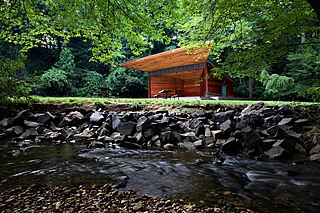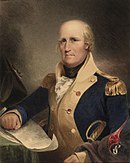The Virginia Portal  Virginia, officially the Commonwealth of Virginia, is a state in the Southeastern and Mid-Atlantic regions of the United States between the Atlantic Coast and the Appalachian Mountains. The state's capital is Richmond and its most populous city is Virginia Beach, though its most populous subdivision is Fairfax County, part of Northern Virginia, where slightly over a third of Virginia's population of 8.72 million live . The Blue Ridge Mountains cross the western and southwestern parts of the state. The state's central region lies predominantly in the Piedmont. Eastern Virginia is part of the Atlantic Plain, and the Middle Peninsula forms the mouth of the Chesapeake Bay. The fertile Shenandoah Valley fosters the state's most productive agricultural counties, while the economy in Northern Virginia is driven by technology companies and U.S. federal government agencies, including the U.S. Department of Defense and Central Intelligence Agency. Hampton Roads is also the site of the region's main seaport and Naval Station Norfolk, the world's largest naval base. (Full article...) Selected article
The Stanley plan was a package of 13 statutes adopted in September 1956 by the U.S. state of Virginia designed to ensure racial segregation in that state's public schools despite the ruling of the Supreme Court of the United States in Brown v. Board of Education of Topeka, Kansas, 347 U.S. 483 (1954). The legislative program was named for Governor Thomas B. Stanley, who proposed the program and successfully pushed for its enactment. The Stanley plan was a critical element in the policy of "massive resistance" to the Brown ruling advocated by U.S. Senator Harry F. Byrd, Sr. (pictured). The plan also included measures designed to curb the Virginia state chapter of the National Association for the Advancement of Colored People (NAACP), which many Virginia segregationists believed was responsible for "stirring up" litigation to integrate the public schools.
The plan was enacted by the Virginia Assembly on September 22, 1956, and signed into law by Governor Stanley on September 29. A federal court struck down a portion of the Stanley plan as unconstitutional in January 1957. By 1960, nearly all of the major elements of the plan (including the litigation curbs aimed at the NAACP) had been struck down by the U.S. Supreme Court and other federal and state courts. The constitutional invalidity of the Stanley plan led new governor of Virginia, James Lindsay Almond, Jr., to propose "passive resistance" to school integration in 1959. The Supreme Court declared portions of "passive resistance" unconstitutional in 1964 and again in 1968. Selected biography
George Rogers Clark (1752 – 1818) was a soldier from Virginia and the highest ranking American military officer on the northwestern frontier during the American Revolutionary War. He served as leader of the Kentucky (then part of Virginia) militia throughout much of the war. Clark is best known for his celebrated captures of Kaskaskia (1778) and Vincennes (1779), which greatly weakened British influence in the Northwest Territory. Because the British ceded the entire Northwest Territory to the United States in the 1783 Treaty of Paris, Clark has often been hailed as the "Conqueror of the Old Northwest."
Clark's military achievements all came before his 30th birthday. Afterwards he led militia in the opening engagements of the Northwest Indian War, but was accused of being drunk on duty. Despite his demand for a formal investigation into the accusations, he was disgraced and forced to resign. He left Kentucky to live on the Indiana frontier. Never fully reimbursed by Virginia for his wartime expenditures, Clark spent the final decades of his life evading creditors, and living in increasing poverty and obscurity. He was involved in two failed conspiracies to open the Spanish-controlled Mississippi River to American traffic. After suffering a stroke and losing his leg, Clark was aided in his final years by family members, including his younger brother William, one of the leaders of the Lewis and Clark Expedition. Clark died of a stroke on February 13, 1818. This month in Virginia history
Random Virginia articleA random generator will select an article about… 
(note: generator may be slow) Things you can do
Tasks
Selected image The Meadow Pavilion at the Wolf Trap National Park for the Performing Arts, Fairfax County, Virginia Did you know -
Fact sheet
State symbols:
Government
Related portalsVirginia topicsSubcategoriesSelect [+] to view subcategories
Associated WikimediaThe following Wikimedia Foundation sister projects provide more on this subject:
Discover Wikipedia using portals |
Purge server cache




























